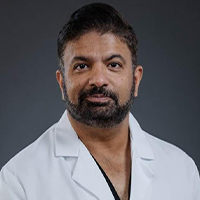Treatment for an Enlarged Prostate
Prostate Artery Embolization (PAE) is minimally invasive, less painful, safer, and offers a lower risk of side effects for those diagnosed with benign prostatic hyperplasia (BPH).
Minimally Invasive
Shorter Recovery Time
Fewer Side Effects
The Prostate Artery Embolization Advantage
Discover why men are choosing this FDA-approved alternative to TURP for treating an enlarged prostate.
If you’ve been diagnosed with benign prostatic hyperplasia (BPH), you may have been told that TURP surgery is your only treatment option. However, did you know that prostate artery embolization (PAE), a non-surgical, FDA-approved alternative to TURP, is being used to successfully treat enlarged prostates?
What is Prostate Artery Embolization?
Prostate artery embolization (PAE) is an interventional radiology treatment for benign prostatic hyperplasia (BPH) that offers a lower risk of urinary incontinence and sexual side effects compared to surgery. BPH is a non-cancerous enlargement of the prostate that can cause difficulty urinating and other urinary symptoms.
The procedure is performed by interventional radiologists, who are specially trained to do minimally invasive vascular procedures. During PAE, a catheter is positioned through a small needle puncture in the leg and into the blood vessels that supply the prostate using X-ray guidance. Tiny microsphere particles are then slowly released to slow the blood supply to the prostate, causing it to shrink.


Faster Recovery. Greater Comfort.
Recovery from PAE is much faster than invasive surgery because there is no incision to heal or stitches to be removed. Patients who undergo PAE have reported high satisfaction and most importantly, no urinary incontinence or sexual side effects. Minor side effects may include frequent and/or difficult urination, pelvic pain, blood in the urine, blood in the stool and diarrhea, but most of these side effects resolve on their own in a few days.
This is in contrast to a traditional surgery like Transurethral Resection of Prostate (TURP) which usually requires 3 to 6 weeks of recovery and a catheter is left in place for 2 to 3 days. TURP also carries a higher risk of complications like excessive bleeding, retrograde ejaculation, and impotence.
Why Choose Washington Vascular Specialists?
At Washington Vascular Specialists, our interventional radiologists are highly trained and experienced. They use state-of-the-art equipment and are committed to providing the best possible outcomes for our patients. Our team is dedicated to ensuring that patients receive the highest quality care in a safe and comfortable environment.
Prostate Artery Embolization (PAE) is an effective and efficient treatment option for BPH that offers a lower risk of urinary incontinence and sexual side effects compared to surgery. If you are suffering from BPH, we recommend that you schedule a consultation with one of our experts to discuss the best treatment option for you.

Get your questions answered about Prostate Artery Embolization to treat your enlarged prostate.

Salman Mufti, MD
Vascular Surgeon
Dr. Salman Mufti is a graduate from Rutgers University Medical School in NJ graduating with the highest honors and a former Edward J. Bloustein Distinguished Scholar. Dr Mufti is performing new cutting edge treatments that involve minimally invasive procedures.
